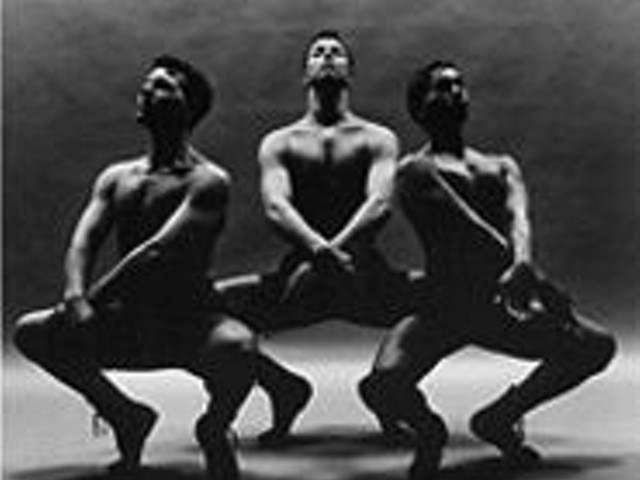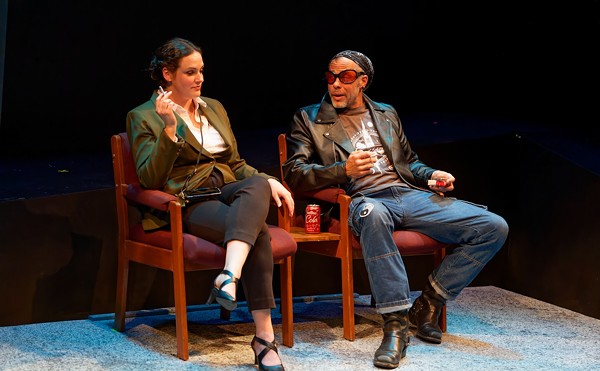Then Washington, playing Rubin "Hurricane" Carter in the recent Norman Jewison film The Hurricane, orders a soda and orders one of the attractive women a soda, too -- like Alan Ladd ordering a sarsparilla in Shane.
The Carter Hurricane audiences don't see was an alcoholic. They do not see the Carter who was an arrogant, high-strutting carouser, a cruel barroom brawler, a man with a penchant for guns, a womanizer. They do not see a juvenile delinquent who stabbed a man while in the act of stealing his gold watch.
They see an African-American man wrongfully accused, who spent nearly 20 years of his life in New Jersey prisons for a triple murder. They see a good man brought down by racism who battles the forces of evil until he is vindicated at last. They see a troubled boy stabbing a white man, defending other black boys from a pederast.
The Rubin Carter of The Hurricane is a cartoon saint.
If Washington represents the ultimate good, then character actor Dan Hedaya represents the ultimate evil -- a scenarist's creation given the something-fishy name of Vincent Della Pesca -- who hounds Carter throughout his life. Det. Della Pesca is the monster from which all misfortune comes.
Less cinematic, although more frightening, is the actual system that put Carter and John Artis behind bars for the murder of three whites in a Paterson bar in 1966 -- the long list of police, prosecutors and judges who found a convenient murder suspect in the former middleweight contender, a symbol of black rage and white fear in the volatile 1960s, another uppity black man to be brought down.
Film audiences do not see Carter today, a man in his 60s living in Toronto -- a man who tends to his garden, works for the rights of the wrongfully accused and no longer watches the sport that gave him his name, a sport he now considers a form of barbarism. Instead, audiences see the final shot, the youthful Hurricane in the black-and-white Friday-night-fight past, arms raised in victory.
Anyone who goes to a movie and expects a factual depiction of historical events is naive, of course. The Hollywood system removes shades of gray, elicits clear distinctions between good and evil and provides a simple narrative: good heroically overcomes the obstacles evil sets in its way. Emotional uplift is achieved. All this and popcorn, too.
James S. Hirsch's authorized biography, Hurricane: The Miraculous Journey of Rubin Carter, is not only a more accurate depiction of Carter's life and times, it is a better story. Evil is presented as evil is, a system of lies rather than a lurking bogeyman. Hirsch finds the good in Rubin Carter through all his faults, a more compelling figure because of his humanity.
Hirsch, in town recently for a booksigning at Library Ltd., doesn't denigrate the film version of Carter's life. The success of his book -- already in a fifth printing after only three weeks in bookstores -- has dovetailed with the popularity of the film. Why complain?
"I think people should see the film," Hirsch says. "It's a great story. Anything that sheds light on Rubin's life or stimulates discussion about his experiences is good. The film does that."
Hirsch also commends the film's producers. A movie about a wrongfully imprisoned African-American man does not have the glow of boffo box-office success, even with superstar Washington in the title role, yet the studio has obviously set all its promotional gears in motion in support of The Hurricane.
Hollywood wasn't one of Hirsch's concerns when he chose to investigate Carter's story, however. Like a lot of journalists, he was in search of a book project. Hirsch's agent learned through the grapevine that Carter might be interested in having someone write his story. Hirsch admits he knew little about Carter's case, but the idea appealed to his interests in sport, pop culture and race.
However, Hirsch's life experience makes him seem an unlikely candidate for Carter's biography. Hirsch grew up in Clayton and went to Clayton High (class of 1980). He attended Mizzou's journalism school and later received a masters in public policy from the LBJ School of Public Affairs in Austin, Texas. He worked three years at the New York Times, starting as a clerk and moving to a one-year reporting stint, then wrote for the Wall Street Journal for nine years.
Hirsch had never boxed; he'd never been in prison; and he was white. Hirsch is soft-spoken and appears much younger than he does in his jacket photo. Somehow the Clayton kid managed to persuade the Paterson brawler that Hirsch was the one to tell the real story, and not the mythology, of "Hurricane" Carter.
"Rubin respects strength," says Hirsch. "He would not have cooperated with this book if he thought I was going to do a puff piece about him. He wouldn't have cooperated if he could intimidate me. Intimidation has always been, and still is to this day, a big part of who he is. If he can roll over you, he will."
Hirsch apparently could hold his own with Carter, despite their disparate backgrounds. Growing up in Clayton, Hirsch admits, "I had more of an academic sense of race relations in American than any firsthand witnessing of racial strife."
He set out to better understand the environment that made Carter: "As a white person, I definitely had to do a lot of research to understand a black person's view of the world. For example, if I felt some threat to my security, or to my family's security, I don't give a second thought of calling the police and asking the police for help.
"If you were a black man in Paterson in the 1960s and you had a problem, or some fear for your safety, you didn't call the police, because you feared the police. The police were more often than not those who were causing the problem.
"I only really came to understand this by going to Paterson and talking to a lot of black people there, and a few white people there. The Paterson city historian is in his 60s now. He told me about how he would be on the streets in Paterson in the '60s and he'd watch the cops beating the hell out of some black guy for no apparent reason. That was the tenor of the times."
Racism was the primary motive for pinning the murder of three whites on the most revered, and feared, African-American in Paterson. "In the first trial," Hirsch explains, "there I think the political pressures were much more intense. They had to find the killer. You couldn't have the specter of black-mob vigilantism stalking across Paterson. The white establishment would never countenance that. You had a mayor who was a law-and-order zealot, who controlled the police. They may have believed something along the lines that "Even if Rubin isn't the killer of this crime, he's a violent person. We'll be doing a good deed if we get him off the streets.'"
Carter's case became a radical-chic cause célèbre in the 1970s, with Bob Dylan's "Hurricane" ("Put in a prison cell, but one time he could have been the champion of the world") and with rallies and fundraisers led by the likes of Muhammad Ali and Ellen Burstyn. But in 1976, Carter and Artis were granted a second jury trial -- and received a second guilty verdict. After this, the celebrities disappeared.
Enter "the Canadians," members of a Toronto commune who threw their money, time and will into Carter's case. Again, the complexities of the commune are diminished in The Hurricane. The commune becomes streamlined into three amorphous characters. They might as well be played by the Coneheads.
The film slyly suggests a budding attraction between the commune's leader, Lisa Peters (played by Deborah Kara Unger), and Carter, a relationship that was tempestuous. "Carter respected Lisa because she didn't take any lip from him," Hirsch observes. "When Rubin tried to push back against her she would cut him to shreds. Rubin wasn't accustomed to that, particularly from a woman. But it's why he trusted her and partly why he fell in love with her."
The prison romance dissolved even before Carter was freed. Carter lived at the commune for a time, but, as Hirsch writes, "he could no more live in a commune than an eagle could live in a bird cage."
Hirsch says the commune still exists, and he interviewed several of its members, although Peters declined to be part of the book. "The core group is still there. They're an intriguing group of people. They're smart. They're resourceful. They're persistent, and they had this worldview. They had this belief in their own exceptionalism -- anything that they put their minds to accomplish, they could do."
In spite of, and partly because of, the media attention paid to Carter, New Jersey authorities still insist on Carter's guilt. The Passaic County sheriff told Hirsch that after 19 years of incarceration, Carter deserves no apology -- rather, he said, Carter owes the state of New Jersey room and board.
The tough realities of Carter's life story can be found in Hirsch's biography. There are villains and heroes in the book, but they are human, not one-dimensional figures made to carry a simple plotline to its inevitable conclusion.
Ironically, the "triumph of the human spirit" motif that Hollywood so dearly loves is more fully realized in the story Hirsch presents. "What separated Rubin's story," his biographer concludes, "was his struggle within."
A struggle not so easily depicted on the big screen.





